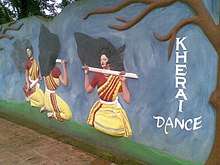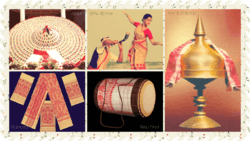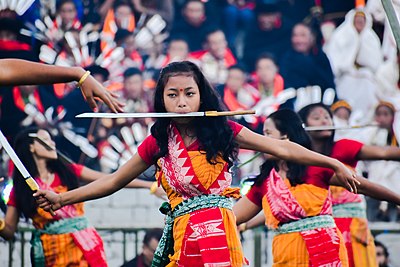Bodo-Kachari people
Bodo-Kachari (also Kachari or Bodo[4]) is a generic term applied to a number of ethnic groups living predominantly in the Northeast Indian states of Assam, Tripura & Meghalaya, that speaks Assamese and Boro-Garo languages, some of who possibly have shared ancestries. Many of these peoples formed early states in the late Medieval era of Indian history and which came under varying degrees of Sanskritisation.
Kachari | |
|---|---|
 Boro Kherai Dance | |
| Total population | |
| c. 12–14 million | |
| Regions with significant populations | |
| Assam | n/a |
| Tripura | n/a |
| Meghalaya | n/a |
| Arunachal Pradesh | n/a |
| Languages | |
| Bodo-Garo languages, Assamese language | |
| Religion | |
| Predominant Minority | |
| Related ethnic groups | |
| |
| Part of a series on the |
| Culture of Assam |
|---|
 |
|
Proto-historic
Classical Medieval
Modern |
|
|
|
Festivals
|
|
Religion Major
Others |
|
History
Archives
Genres
Institutions
Awards
|
|
Music and performing arts |
|
Media |
|
Symbols
|
It has been suggested by different linguists that the proto-Boro-Garo language was a lingua franca of the region to which non-native speakers had shifted.[5] Bodo language, one of the languages in the Boro-Garo group, has been recognised as an eighth scheduled Indian language in 2004.[6]
They are considered to have reached the Brahmaputra valley via Tibet and settled in the foothills of the eastern Himalayan range which includes the whole of Assam, Tripura, North Bengal and parts of Bangladesh. The belief that Bodo-Kacharis were early settlers of the river valleys is taken from the fact that most of the rivers in the Brahmaputra valley today carry Tibeto-Burman names—Dibang, Dihang, Dikhou, Dihing, Doiyang, Doigrung etc.—where Di/Doi- means water in Boro-Garo languages.
Some of the groups, such as Moran and Saraniya consider themselves as Hindus under Ekasarana Dharma. Other groups, such as the Garo, Rabha, Lalung and Hajong have established separate identities. With the exception of the Garo, which is still a matrilineal society, the other groups do not follow rules of matrilineal society.
The Mech in Western Assam, the Boro in central Assam; the Dimasa in Dima Hasao District (DHD) formerly North Cachar Hills, Cachar district and Nagaland state and the Sonowal and Thengal in the eastern part of the Brahmaputra now represent the Kachari.
Etymologies
Bodo
The term Bodo finds its first mention in the book by Hodgson in 1847, as a term of self-designation of the Mech and Kachari peoples.[7][8] Grierson took this term Bodo to denote a section of the Assam-Burma group of the Tibeto-Burman languages of the Sino-Tibetan family,[9] which included the languages of (1) Mech; (2) Rabha; (3) Lalung (Tiwa); (4) Dimasa (Hills Kachari); (5) Garo (6) Tiprasa and (7) Chutiya.[10] In modern usage, the umbrella-term Bodo is more anthropological and linguistic in its usage.[11] Modern historian Jae-Eun Shin use the Bodo as a linguistic group to include cognate groups[12] . This umbrella-group includes such sub-groups as Mech in Bengal and Nepal; Boros (also confusingly called Bodo[13]), Dimasa, Chutia, Sonowal, Rabha, Tiwa in Assam, and the Kokborok people in Tripura and Bangladesh.[14][4] This is in contrast to popular and socio-political usage, where Bodo denotes the politically dominant sub-group—the Boros—in the Bodoland Territorial Autonomous Districts.[15][16] In general, the Boros or Bodo people means Boro people and scholars use the term Bodo to name the linguistic and anthropological group.
The term Bodo generally stands for man in some of the cognate languages (Boro:Boro; Tripuri:Borok) but not in others (Garo:Mande; Karbi:Arlen).[17] According to historians, the word "Bodo" is derived from the Tibetan Hbrogpa.[18]
The umbrella name "Bodo" is resisted by numerically smaller groups such as the Dimasas.[19]
Kachari
On the other hand, the term Kachari has been used through much of history to denote the same people.[20] One of the earliest usage can be found in the 16-th century Assamese language Bhagavata.[21] Kachari is pronounced as Kachhāri or Kossāri. The origin of the name is most likely a self-designation korosa aris that is found in a very old Kachari song:[22]
Pra Ari, Korasa Ari
Jong pari lari lari
(We are Korosa Aris, first-born sea race
Our line is continuous)
Ethnic groups
Boro
The Boro people, also called Bodo, are found concentrated in the duars regions, north of Goalpara and Kamrup. The origin of Kachari term was unknown to Boro themselves, but known to others. They call themselves as Boro, Bada, Bodo, Barafisa. Barafisa translated as Children of the Bara.
Mech
The Mech are found in both Assam and Bengal. Hodgson(1847) wrote as "Mech is name imposed by strangers. This people call themselves as Bodo. Thus, Bodo is their proper designation" They speak mainly the Bodo language[23] J.D Anderson wrote, "In Assam proper Hindus call them Kacharis, In Bengal they are known as Meches. Their own name for the race is Boro or Bodo."[24]
Dimasa
The Kachari have a ruling clan among themselves who are termed as Hasnusa. Some Dimasa scholars opined that they were also known as Hasnusa at some point of time in History[25]
Chutiya
Among Chutias, Burok means noble/great men. The Buroks formed a major part of the tribe. The Chutias who were thought to be healthy and strong was termed as Burok and took up the administrative and military roles in the Chutia kingdom. All Chutia royalty belonged to the Burok clan. Even the Motok king Sarbananda Singha belonged to the Burok Chutia clan.[26] Surnames like Bora, Borha, Borua have their origins in the Chutia kingdom and are related to Bara/Bodo/Buruk only. There is mention of Manik Chandra Barua, Dhela Bora, Borhuloi Barua as commanders of Chutia army. Later the Ahoms adopted the title after the downfall of Chutias.[27][28]
Moran
The Morans called their leader/chief as Bodousa (great son) where 'sa' means child or son in Moran language . The origin folklore of the Morans is same as that of Boruk Chutias which indicate that they were a faction which split at an early time.[29] They were also known as Habungiya or earth-folk or autochthones which means son of soil[30]
Deori
The Deoris (who were priests by profession) also have the Burok clan among them.
Twipuri
The Tripuris often call themselves Boroks and their language is called Kokborok.[31]
Origins

They were first classified by S. Endle as the Kacharis. They are considered to have reached the Brahmaputra valley via Tibet and South China, and settled in the foothills of the eastern Himalayan range which includes the whole of Assam, Tripura, North Bengal and parts of Bangladesh. That the Bodo-Kacharis were early colonizers of the river valleys is taken from the fact that most of the rivers in the Brahmaputra valley today carry Tibeto-Burman names – Dibang, Dihang, Dikhou, Dihing, etc. – where Di- means water in Bodo/Deori-Chutia, Moran, Dimasa, other dialects Bodo languages. ("Ti" in Lalung (Tiwa) language, "Twi" in Tripuri language, "Dwi" in 8th scheduled Boro & "Chi" in Garo). There are many places name given by Bodo-Kachari people are Dispur, Dinajpur, Dimapur, Dibrugarh, Hajo, Mongoldoi, Diphu etc.
Groups
Based on an 1881 census, there were 19 groups within the Kachari classification:
- Boro
- Chutia
- Dhimal
- Garo
- Hajong
- Koch
- Lalung (Tiwa)
- Dimasa
- Mech
- Moran
- Modahi
- Phulgaria
- Deuri
- Rabha
- Sonowal Kachari
- Sarania kachari
- Solaimiya
- Thengal Kachari
- Tiprasa – Bru(Reang), Jamatia, Uchai, Noatia(Tripura), Debbarma, Murasing, Roaza, etc.
Some of the groups, such as Moran and Sarania consider themselves as lower-caste Hindus. Other groups, such as the Garo, Rabha, Lalung (Tiwa) and Hajong having been isolated from the parental stock, have established separate identities. With the exception of the Garo, which is still a matrilineal society, the other groups have given up the rules of matrilineal society.
The Mech in Western Assam, the Boro in central Assam; the Dimasa in Dima Hasao district formerly North Cachar Hills, Nagaon district, Cachar district & Nagaland state and the Sonowal and Thengal in the eastern part of the Brahmaputra now represents the Kachari.
History
The Tripuri, Chutia, Koch-Mech and Dimasa had established powerful kingdoms in the past. The Tripuri kings had even defeated the Mughals and the Burmese kingdoms in the past. Today, the Boros, the Tripuris, and the Garos have established a strong political and ethnic identity and are developing their language and literature. The Sonowal Kachari is also a branch of greater Kachari. They live in the districts of Dibrugarh, Tinsukia, Dhemaji, Sivasagar, Lakhimpur, Golaghat and Jorhat.
Notes
- "639 Identifier Documentation: aho – ISO 639-3". SIL International (formerly known as the Summer Institute of Linguistics). SIL International. Retrieved 29 June 2019.
Ahom [aho]
- "Population by Religious Communities". Census India – 2001. Ministry of Home Affairs, Government of India. Retrieved 1 July 2019.
Census Data Finder/C Series/Population by Religious Communities
- "Population by religion community – 2011". Census of India, 2011. The Registrar General & Census Commissioner, India. Archived from the original on 25 August 2015.
- "The term Bodo is also used to denote a large number of tribes-the Garos of Meghalaya, Tippera of Tripura, and Boro Kachari, Koch, Rabha, Lalung, Dimasa, Hajong, Chutia, Deuri, and Moran of Assam and other parts of the Northeast. (M N Brahma, "The Bodo-Kacharis of Assam---A brief Introduction" in Bulletin of the Tribal Research Institute [Gauhati], 1:1 [1983], p.52)" (George 1994, p. 878f)
- "Briefly, I propose, following a suggestion by Burling (2007), that the Proto-Bodo-Garo first as a lingua franca used for communication across the various linguistic communicates of the region and its striking simplicity and transparency reflect a period when it was widely spoken by communities for whom it was not a native language." (DeLancey 2012:3)
- Govt. of India, Ministry of Home Affairs. "Eight Schedules" (PDF). mha.nic.in. Archived from the original (PDF) on 5 March 2016. Retrieved 13 October 2016.
- (Bathari 2014:15) The term Bodo finds its textual space first time in the book by Brian Hodgson, who wrote about a section of Tibeto-Burman speech group claiming themselves as Bodo.
- "As (Hodgson) admits in the end, his way of seeing the “Bodos” is twofold: he starts by using “Bodo” to designate a wide range of people (“a numerous race”), then wonders if some others are not “Bodos in disguise”. He ends on a cautionary note and refrains from unmasking the dubious tribes, registering only the Mechs and Kacharis,..." (Jaquesson 2008:21)
- Choudhury 2007, p. 1.
- Grierson 1903, p. 2.
- "[I]t seems that the term Bodo is used particularly to denote sections of people having an agnatic relationship in terms of speech practices and a strong sense of shared ancestry. This term the Bodo is more anthropological in its usage." (Bathari 2014:14)
- (Shin 2020:51) The Chutiyas belong to the Bodos, a linguistic group of the Brahmaputra valley, speaking a Tibeto-Burman language and having different cognate groups within them
- Chaterji uses Bodo for both the umbrella group as well as the Boro: "the Bodo speeches- Bodo, Mech, Rabha, Garo, Kachari and Tipra and a few more" (Chaterji 1974:23)
- (Bathari 2014:14)
- "In present-day socio-political terminology, the Bodo means the plains tribes of the Brahmaputra Valley known earlier as Bodo-Kachari." (Choudhury 2007, p. 1)
- "The media at the regional and national level; officials at the Centre and the state political parties of all hues and the people, in general, have accepted what may be termed as a contraction of the original denotion." (Choudhury 2007, p. 1)
- "One section of the same stock, Garo, a Tribe called themselves “Mande” means Man: another word Arleng (Karbi) is popularly used among Karbis, which literally means Man." (Brahma 2008:1–2)
- "The inception of the term 'Boro' may be traced from a Tibetan word 'Hbrogpa' an inhabitant of steppes belongs to Mongolean race." (Brahma 2008:2)
- This has been viewed with contempt by several sections of the groups as a design by the Boros to establish their pre-dominance over numerically and otherwise weaker sections of the group. Most of the resistance has come from the Dimasas, who often accuse the Boros of appropriating the history and language of the Dimasas.(Bathari 2014, p. 14-15)
- "On the other hand, for the larger part of history, this group of people is referred to as Kacharis." (Bathari 2014:14)
- Srimandbhagavat, skandha 2, H Dattabaruah and Co., Nalbari, pp-38: kiraTa kachhaari khaachi gaaro miri / yavana ka~Nka govaala /
- (Mosahary 1983:47)
- Hodgson, B.H. (1847). Essay the first; On the Kocch, Bódo and Dhimál tribes. Calcutta: J. Thomas. pp. 105, 142, 154, 155, 156.
Mech is name imposed by strangers. This people call themselves as Bodo. Thus, Bodo is their proper designation
- (The Kacharis & J.D Anderson:xv)
- The Dimasa were known as kachari who migrated to Dimapur region and settled on the banks of Dhansiri, and later came to be known as Dimasa
- "Nath, D. The Mataks and their Revolt, p.13" (PDF). Archived from the original (PDF) on 19 August 2016. Retrieved 22 November 2019.
- Dr. Swarnalata Baruah(2004), Chutiya Jaatir Buranji, Page 145, Surnames like Bora, Saikia, Kataki, Tamuli,etc. were found in Chutia kingdom. It is clearly stated in the Deodhai Buranji that when Ahom king Suhungmung attacked the Chutia kingdom on the banks of Dihing river, the Chutia army was led by one Manik Chandra Baruah. The surname "Neog" was probably derived from the Chutia "Nayak" whose duty was the same. Deori folklores also mention the myths behind the creation of each of these titles. For instance, "Bora" was said to be derived from the "Buruk" clan and acted either as a military official or a temple guard...
- Dr. Swarnalata Baruah(2004), Chutiya Jaatir Buranji, Page 129, The Chutia army was led by Borhuloi Borua and Dhela Bora.
- Moran chief Badaucha
- (Endle 1911:88)
- Tripuris are called Boroks
References
- Jacquesson, François (2008). "Discovering Boro-Garo" (PDF). History of an Analytical and Descriptive Linguistic Category. Archived from the original (PDF) on 3 August 2019. Retrieved 23 March 2020.
- Sharma, Chandan Kumar (2006), "Oral discourse and Bodo identity construction", in Muthukumaraswamy, M.D. (ed.), Folklore as Discourse, National folklore support centre, pp. 73–94, ISBN 9788190148160
- Bathari, Uttam (2014). Memory History and polity a study of dimasa identity in colonial past and post colonial present (PhD). Gauhati University. hdl:10603/115353.CS1 maint: ref=harv (link)
- Brahma, Nirjay Kumar (2008). Socio political institutions in bodo society (PhD). Gauhati University. hdl:10603/66535.CS1 maint: ref=harv (link)
- Burling, Robbins (2013). "The Tibeto-Burman Languages of Northeastern India". In LaPolla, Randy J. (ed.). Sino-Tibetan languages. Routledge.CS1 maint: ref=harv (link)
- Choudhury, Sujit (2007). The Bodos: Emergence and Assertion of an ethnic minority. Shimla: Indian Institute of Advanced Study. ISBN 9788179860540.CS1 maint: ref=harv (link)
- Endle, Sidney (1911). The Kacharis. London: Macmillan and Co. Retrieved 20 February 2013.CS1 maint: ref=harv (link)
- Basu, Analabha (2003). "Ethnic India: A Genomic View, With Special Reference to Peopling and Structure". Genome Research. 13 (10): 2277–2290. doi:10.1101/gr.1413403. PMC 403703. PMID 14525929.CS1 maint: ref=harv (link)
- George, Sudhir Jacob (1994). "The Bodo Movement in Assam: Unrest to Accord". Asian Survey. University of California Press. 34 (10): 878–892. doi:10.1525/as.1994.34.10.00p0431w.CS1 maint: ref=harv (link)
- Grierson, George A. (1903). Linguistic Survey of India. Volume III, Part 2, Tibeto-Burman family. Specimens of the Bodo, Nāgā, and Kachin groups. Calcutta: Office of the Superintendent of Government Printing, India.
- Mosahary, R N (1983). "The Boros : Their Origin, Migration and Settlement in Assam" (PDF). Proceedings of Northeast India History Association. Barapani: Northeast India History Association. pp. 42–70. Archived from the original (PDF) on 1 July 2019. Retrieved 30 June 2019.CS1 maint: ref=harv (link)
- Narjinari, Hira Charan (2000). Reassertiveness of the Great Bodos.CS1 maint: ref=harv (link)
- GoI. Eighth Scheduled Indian Languages (PDF). Archived from the original (PDF) on 5 March 2016. Retrieved 13 October 2016.
- Chatterjee, S.K. (1970). The place of Assam in the history and civilisation of India. Guwahati University.
- Chatterji, S. K. (1974). Kirata-Jana-Krti. Calcutta: The Asiatic Society.CS1 maint: ref=harv (link)
- DeLancey, Scott (2012). Hyslop, Gwendolyn; Morey, Stephen; w. Post, Mark (eds.). "On the Origin of Bodo-Garo". Northeast Indian Linguistics. 4: 3–20. doi:10.1017/UPO9789382264521.003. ISBN 9789382264521.
- Shin, Jae-Eun (2020). "Descending from demons, ascending to kshatriyas: Genealogical claims and political process in pre-modern Northeast India, The Chutiyas and the Dimasas". The Indian Economic and Social History Review. 57 (1): 49–75. doi:10.1177/0019464619894134.CS1 maint: ref=harv (link)
- Barua, Birinchi Kumar (1964). History of Assamese Literature. East-West Center Press.
.jpg)
